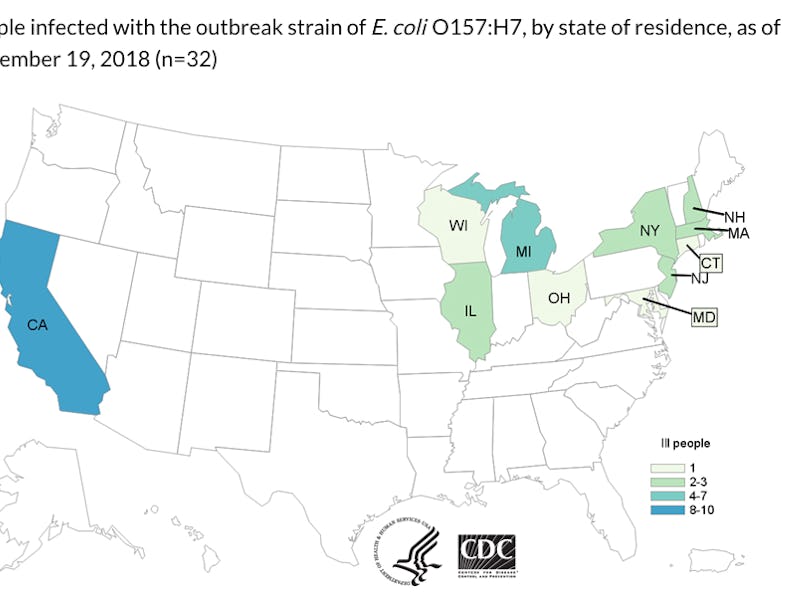November 2018 E. Coli Map Shows Where Romaine Lettuce Has Made People Sick
The CDC is warning people to throw away all their romaine.

Two days ahead of the nation’s biggest meal of the year, the Centers for Disease Control i Atlanta is warning all members of the public to avoid eating any romaine lettuce. The culprit is E. coli.
On Tuesday afternoon, the CDC released the following information about the outbreak strain of Shiga toxin-producing E. coli O157:H7: Some 32 people in 11 states have been infected with the disease. Thirteen people have been hospitalized. There have been no deaths and no official product recalls. Instead, the CDC is advising people to throw out their romaine and for restaurants to take it off the menu.
Cases have been reported in California, Connecticut, Illinois, Massachusetts, Maryland, Michigan, New Hampshire, New Jersey, New York, Ohio, and Wisconsin.
California has reported 10 cases, Michigan 7, and New Jersey has 3 cases.
People began getting sick from this breakout between October 8 and October 31, and range in age from 7 to 84 years old, with a median age of 24. One person developed hemolytic uremic syndrome, a type of kidney failure, the CDC reports.
It takes a few weeks to get sick from E. coli, and the CDC advises that new cases after October 30 may not be reported yet.
This rash of illnesses is related to a strain from 2017 that linked with leafy greens in the US and Canada. The CDC says this outbreak is not related to the one from this past spring, as that had a different DNA fingerprint. As this map from June shows, things can get much worse.
Romaine lettuce is known to have caused two other E. coli outbreaks before this year, one in 2011, with 26 cases, and one in 2010, with 56 cases. It isn’t that romaine lettuce is naturally bacteria prone; it’s that, by its nature and the way that it’s grown and sold, the leafy green has many opportunities to get contaminated.
The United States Food and Drug Administration’s Good Agricultural Practices is a set of guidelines meant to prevent contamination from happening in the first place, devised for the simple reason that veggies grow outside, in the dirt, and as such are subject to a multitude of potentially bacteria-laden external inputs, like fertilizer, animal poop, tainted water, and dirty human hands. These concerns apply to romaine lettuce, though a lot of its potential for infecting people are inherent not only to the way it’s grown but to the way that it’s treated and used post-harvest.
Watch this: How to protect yourself from e. Coli:
With additional reporting by Yasmin Tayag.